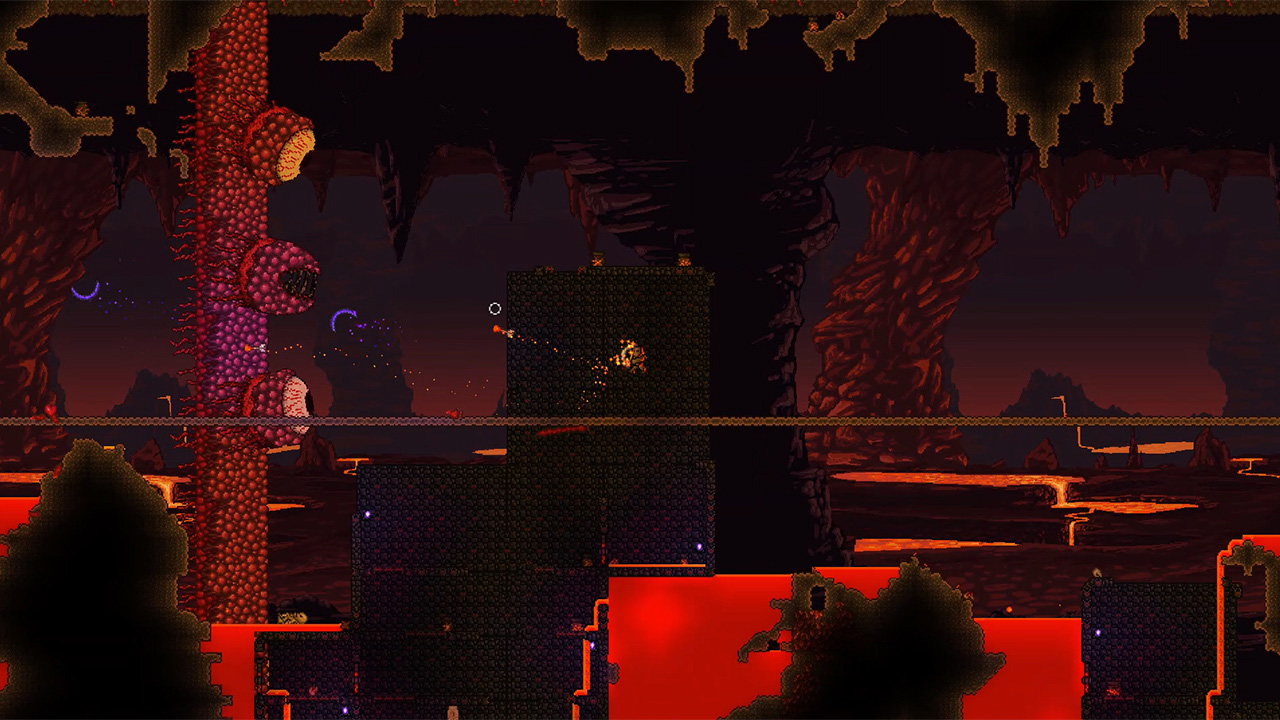Over 8 years have passed since the initial release of Terraria, called a Minecraft clone at the time with a 2D twist this little indie game had a lot going against it in the big world of gaming. Since then it has seen several updates, over 27 million sales, releases on consoles and a huge fan base behind it. Looking back at how this indie title was released and the content it had at the time is a staggering difference when compared to the 1.3 state it currently is in, from difficulty modes to the sheer number of bosses.

Terraria isn’t a typical game when it comes to story, similar to Minecraft which it was likened to for so long in the beginning. You simply appear within a randomly generated world to then explore and enjoy the gameplay. Whilst not enforced, you can go out of your way to attack the bosses that protect certain areas, spawn after events or even via item use. Defeating certain bosses will change the world into the next phase, adding in new biomes, items and bosses, turning the game into what is known as “hard mode”. Continually going further and further into the game will unlock new challenges and new rewards.
To fully complete what Terraria has to offer you will have to take down around 30 different bosses, both around the world as well as from random events. However, it isn’t as simple as just killing the bosses as plenty have time restraints, battle arenas as well as other factors that go into both their defeat and their summoning. Multiplayer can also either make this journey a more lengthy experience or one that is much easier.

If you’re on PC the game can be expanded even further with a plethora of mods at hand to add in new items, bosses, events, areas and more. The fun never stops when you can throw in Ori and the Blind forest into the game or even full story expansions by the minds of the community.
The gameplay in Terraria is very straightforward, WASD for movement, interactions with left click and jump with spacebar. As you move further into the game you can get grappling hooks to aid in traversing mines, wings to fly, mounts to move faster and an array of weaponry from melee and ranged to magical and summoning. Designed as more of a combat orientated survival, crafting game, Terraria features countless options for builds of your character.

From the original concept, Terraria has added hundreds of new ways to make your character, along with a pseudo-class system with gear modifiers. You can make a summoning genius, with increased minion numbers as well as their damage or a mage whose spells take little to no mana to cast alongside increased damage and effects. Due to the “classes” being tied to equipment you can keep a set of gear in your inventory to swap on the fly, moving to a more rogue type build for specific areas or a tanky setup to protect against specific bosses.
As you explore the world, defeat bosses or free NPCs that are trapped you will gain the ability to attract new villagers to any houses you build in the world. Making a little village to fill up with shopkeepers, guides, guards and more is a great aspect of the game that Minecraft lacked for so long, even now. This sense of reward for your actions feels great, especially when some NPCs unlock new builds, items and quests to undertake. The loop within the game is amazingly crafted, with ever-increasing difficulty alongside new mechanics to explore.

Exploring and defeating enemies isn’t the only fun to be had within the game, you can craft, build structures and even setup electrical systems for automated traps or teleporters. Cutting down trees allows you to build wooden weapons and structures, mining for ore will allow you to smelt ingots for better equipment and so on and so forth. Getting better gear speeds up your traversal, mining as well as makes fighting easier which in turns rewards you with more loot.
The music of Terraria has improved over the years, filling the somewhat empty world from 2011 with vibrant tunes that fit the art style perfectly. Plenty of bosses have their own music, areas have their own style of songs and they all blend together very well. While the music has improved there hasn’t been too much of a graphical improvement, as the art style is pretty stylised. Though the game has added plenty of incredibly designed bosses that blow any sort of disappointed over the art style out of the water.

Due to all the additions and updates over the years Terraria is still flourishing, keeping that “1 more hour” aspect 8 years later. Even after 200 hours I still feel the pull of the game to create a server and invite a few friends to take on the world in expert mode. With even more updates planned in the future, with “Journey’s End” we can expect to see the game evolve even more.
Overall, Terraria gets a 10/10, there really isn’t much the game does wrong at all, the improvements have gotten rid of any major bugs and made any aspect that was boring more enjoyable. If there was any fault I could find it would be the lack of story, but you can craft your own as you play or even amongst friends. Priced at £7 normally, and getting discounted quite often, Terraria is a safe purchase for anyone who is a fan of crafting, building or 2D action-adventure games.
Terraria is out on Nintendo Switch, PC, Xbox One. PS4 and mobile devices.








You must be logged in to post a comment.